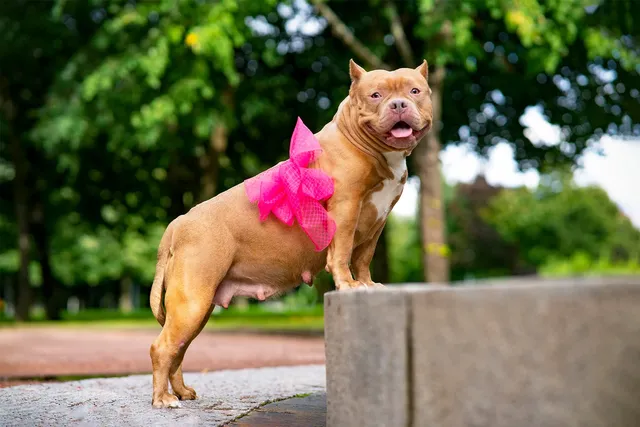Pit bull pregnancy is an exciting time for pet owners, but it requires proper care to ensure the health of both the mother and puppies. The gestation period for pit bulls is typically around 63 days, during which various milestones occur, such as fertilization, implantation, fetal development, and birthing.
It is crucial to practice responsible pet ownership by taking the necessary steps to ensure the health of both mother and pups. Pregnant pit bulls should be provided with a high-quality, nutritionally balanced diet that meets their increased energy needs, plenty of clean water, and low-impact exercise.
Regular veterinary check-ups are crucial for monitoring the health of both the mother and growing fetuses, and stress reduction is essential to keep the mother calm and comfortable. It is also important to create a quiet and safe area for the mother to give birth and to keep her isolated from other dogs three weeks before labor and three weeks after delivery to prevent the spread of diseases.
Signs of dog pregnancy include an increase in appetite, weight gain, increase in nipple size, swollen belly, nesting behavior, and more affectionate behavior. It is crucial to contact a reproductive veterinarian before breeding your dog to keep her and her puppies as healthy as possible.
While there is no hard scientific backing to the idea, some people believe that dogs can sense pregnancy, and they may exhibit more clingy or protective behavior. Overall, the risks involved with a pit bull giving birth are very small provided you take sensible precautions such as maintaining her on a good diet and providing proper care.
Pit bull pregnancy typically lasts around 63 days, but it can vary depending on the size of the litter. During this time, various milestones occur, such as fertilization, implantation, fetal development, and birthing. It is crucial to practice responsible pet ownership by taking the necessary steps to ensure the health of both mother and pups. Pregnant pit bulls should be provided with a high-quality, nutritionally balanced diet that meets their increased energy needs, plenty of clean water, and low-impact exercise.
Regular veterinary check-ups are crucial for monitoring the health of both the mother and growing fetuses, and stress reduction is essential to keep the mother calm and comfortable. Signs of dog pregnancy include an increase in appetite, weight gain, increase in nipple size, swollen belly, nesting behavior, and more affectionate behavior. It is important to contact a reproductive veterinarian before breeding your dog to keep her and her puppies as healthy as possible.
While there is no hard scientific backing to the idea, some people believe that dogs can sense pregnancy, and they may exhibit more clingy or protective behavior. It is also important to create a quiet and safe area for the mother to give birth and to keep her isolated from other dogs three weeks before labor and three weeks after delivery to prevent the spread of diseases. Overall, the risks involved with a pit bull giving birth are very small provided you take sensible precautions such as maintaining her on a good diet and providing proper care.
Caring for a pregnant pitbull involves several important aspects, including nutrition and diet, common signs of pregnancy, exercise, veterinary care, and preparing for birth. Here’s a detailed overview of each aspect:
Nutrition and Diet
- A high-quality, nutritionally balanced diet is essential for a pregnant pitbull to meet her increased energy needs[1].
- During the third trimester, the abdomen is filled with puppies, leaving little room for food, so it’s recommended to provide a highly digestible, high-quality puppy/growth/development formulation and offer multiple small meals to maintain adequate nutrient and calorie intake.
- The mother’s energy requirement may be 30-60% higher than normal adult maintenance rations, depending upon the size of the litter.
- Supplementation with folic acid and essential fatty acids may be beneficial to support developing fetuses, but it’s important to consult a veterinarian regarding their use.
Common Signs of Pregnancy
- Signs of dog pregnancy include an increase in appetite, weight gain, increase in nipple size, swollen belly, nesting behavior, and more affectionate behavior.
- Some dogs may exhibit signs of a false pregnancy, so it’s important to consult a veterinarian to confirm the pregnancy.
Exercise
- Regular, low-impact exercise is important, especially during the first 30 days of pregnancy, to help the dog maintain muscle tone, which can impact the pregnancy and the birthing process.
- A short 10 to 15-minute walk once or twice per day is recommended during the early stages of pregnancy.
- A game of catch can also be a suitable, non-strenuous activity for a pregnant dog.
Veterinary Care
- It is crucial to contact a reproductive veterinarian before breeding your dog to keep her and her puppies as healthy as possible.
- Regular veterinary check-ups are crucial for monitoring the health of both the mother and growing fetuses.
- Diagnostic testing, such as palpation, hormone tests, and X-rays, can be conducted to determine pregnancy and prepare for birth.
Preparing for Birth
- Creating a quiet and safe area for the mother to give birth is important, and she should be isolated from other dogs three weeks before labor and three weeks after delivery to prevent the spread of diseases.
- It’s essential to monitor the mother’s weight and body condition, and prepare for the whelping process by creating a warm and comfortable nesting area.
In summary, caring for a pregnant pitbull involves providing a high-quality, balanced diet, monitoring common signs of pregnancy, maintaining regular, low-impact exercise, seeking regular veterinary care, and preparing for the birth process. It’s important to consult a veterinarian for personalized guidance and to ensure the health and well-being of the mother and her puppies.
Pregnant Pitbull Nipples
During the early stages of pregnancy, the nipples of a pregnant pitbull may start to change. The following are the typical changes that may be observed in a pregnant pitbull’s nipples:
- Weeks One and Two: At this early stage, it is unlikely that you will notice any change in the coloration or size of your dog’s nipples[3].
- Week Three: At this stage, your dog’s nipples’ appearance will become noticeably rounder, or they won’t. This is perfectly fine because your dog has already had puppies, and her nipples have remained round after they finished nursing.
- Weeks Four through Seven: This is when it will become apparent that your dog is pregnant or falsely pregnant. Her nipples’ appearance might darken a bit more in pigmentation from increased blood flow and will become slightly more.
- Weeks Eight and Nine: At this final stage, your dog will lose most of the fur on her tummy, if she has any that has grown back after her previous litter. When the time is near in the final week, your dog will likely begin leaking colostrum. Once the colostrum is in the bellies of her puppies, she will start to produce milk.
These changes in the nipples are typical indicators that a dog is pregnant. It’s important to monitor these changes and seek veterinary advice if there are any concerns or unusual signs.






Leave a Reply